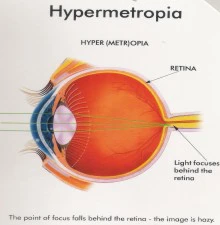What is hypermetropia?
Hypermetropia, or long-sightedness, is a refractive error where distant objects may be seen more clearly than nearby objects. It occurs when the eyeball is too short or the lens is not curved enough.
How is hypermetropia corrected?
Hypermetropia is typically corrected with plus power lenses or glasses that help focus light directly on the retina.
How does Ayurveda classify refractive errors like hypermetropia?
In Ayurveda, refractive errors are categorized under different types of Timir, which refers to visual disturbances. Hypermetropia is influenced by the balance of Vata and Kapha doshas.
What Ayurvedic treatments are recommended for hypermetropia?
Treatment includes Snehapana (oleation therapy), Virechana (therapeutic purgation), followed by Nasya (nasal administration), Tarpana (nourishment of the eyes), Seka (pouring of medicated liquids), and Aschyotana (eye drops).
How does Nasya help in treating hypermetropia?
Nasya helps to clear the vitiated doshas from the body, particularly Kapha, which is essential for managing refractive errors.
What role do eye exercises play in treatment?
Eye exercises can strengthen eye muscles, improve focus, and enhance overall eye health, contributing to better vision and potentially reducing the power of corrective lenses.
What dietary recommendations are suggested in Ayurveda for hypermetropia?
A diet rich in vitamins A, C, and E, as well as omega-3 fatty acids, is beneficial. Foods like leafy greens, carrots, and fish are recommended to support eye health.
Can Ayurvedic treatments stabilize the progression of hypermetropia?
Yes, Ayurveda aims to stabilize the condition and improve vision quality through a holistic approach involving lifestyle changes, herbal remedies, and eye care procedures.
TiAre there any risks associated with Ayurvedic treatments for hypermetropia?
Ayurvedic treatments are generally safe when conducted by qualified practitioners. However, it’s important to consult with an eye specialist to ensure comprehensive care.
How can I start Ayurvedic treatment for hypermetropia?
You can contact Astang Ayurveda hospital in Bhubaneswar, India, to schedule a consultation with their Ayurvedic eye specialists for personalized treatment plans.

